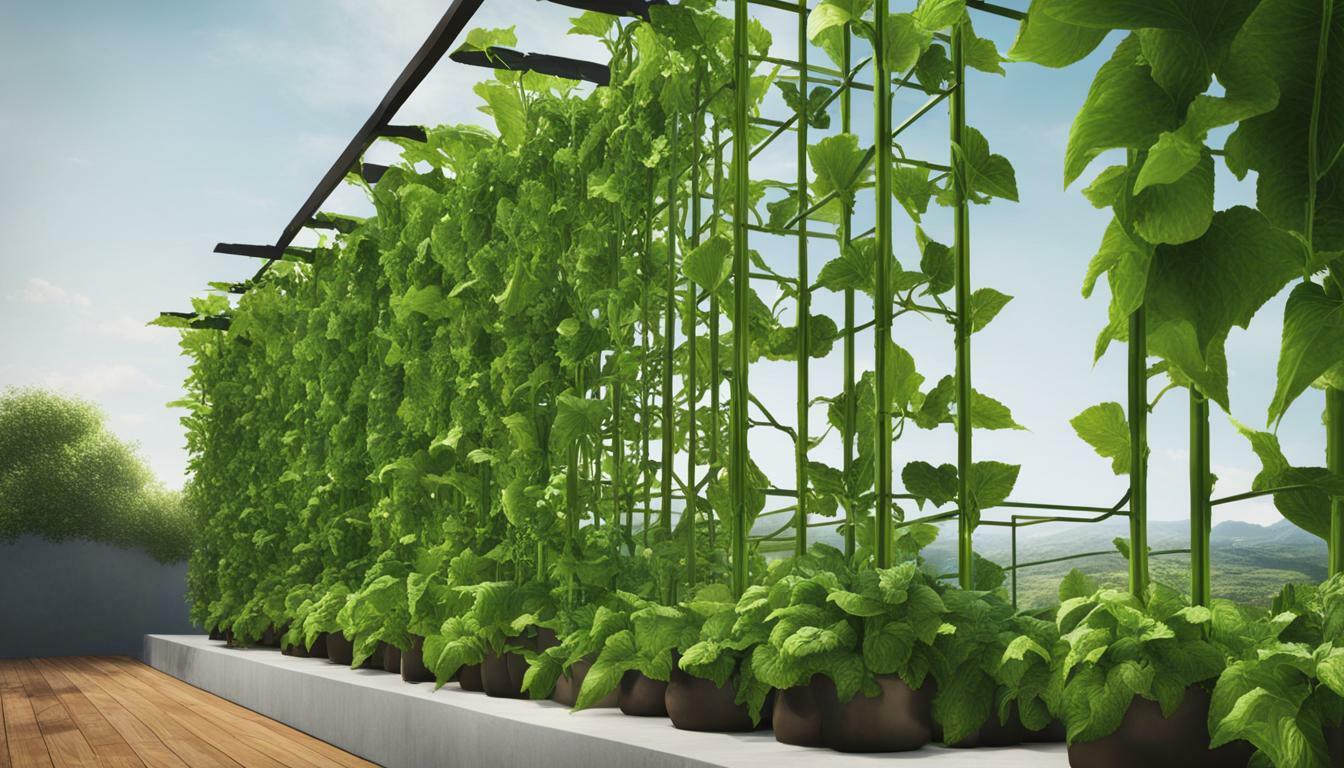Welcome to our comprehensive guide on vertical garden zucchini, designed to help US gardeners master the art of growing zucchini vertically and maximize their harvests. Growing zucchini vertically has become increasingly popular among gardeners in the United States, thanks to its numerous benefits and space-saving advantages.
Vertical gardening is the practice of growing plants upwards, utilizing a trellis or other vertical structures to support the plant’s growth. This technique is especially beneficial for zucchini, a fast-growing summer squash that tends to take up a lot of space in traditional garden beds. By growing zucchini vertically, you can save space in your garden, increase yields, and prevent pest problems by keeping the plants off the ground.
Choosing the right trellis is crucial for successful vertical zucchini gardening. The trellis should be sturdy enough to support the weight of the zucchini plants and their fruit. There are various types of trellises available, including wire mesh, wooden frames, metal pipes, and bamboo poles. Each type has its advantages and considerations, and we will explore them in detail in Section 3.
Not all zucchini varieties are suitable for vertical gardening. Some zucchini plants have a compact bush growth habit and are not well-suited for training to grow vertically. However, there are specific zucchini varieties that are vining in nature and thrive in vertical gardens. In Section 4, we will recommend the best zucchini varieties for vertical gardening.
Planting zucchini on a trellis requires a specific technique to ensure proper growth and support. In Section 5, we will provide a step-by-step guide on how to plant zucchini on a trellis, from preparing the soil to guiding the plant’s growth. Following these steps will help you achieve a successful vertical zucchini garden.
Maintaining and pruning zucchini plants in a vertical garden is essential for their health and productivity. In Section 6, we will share tips and techniques for maintaining and pruning zucchini in a vertical garden, including proper watering, fertilization, and pest control.
Pest and disease management is crucial for the success of any garden, including vertical zucchini gardening. In Section 7, we will discuss common pests and diseases that can affect zucchini plants and provide strategies for effective management and prevention.
Harvesting zucchini from a vertical garden can be a rewarding experience. In Section 8, we will explore techniques for harvesting zucchini at the right time and share creative ways to use your abundant zucchini harvest in the kitchen.
Like any gardening endeavor, vertical zucchini gardening can come with its challenges. In Section 9, we will address common issues that may arise, such as plant diseases, nutrient deficiencies, and environmental factors, and provide troubleshooting tips and solutions.
Throughout this guide, we will share success stories and testimonials from US gardeners who have achieved great results with vertical zucchini gardening. These stories will inspire and motivate you to embark on your own vertical gardening journey.
Finally, in Section 11, we will provide valuable tips for extending the vertical zucchini growing season, allowing you to enjoy fresh zucchini for an extended period. These tips will help you maximize your harvest and make the most of your vertical garden.
In conclusion, vertical garden zucchini offers a practical and space-saving solution for US gardeners. By following the techniques and tips outlined in this guide, you can master the art of growing zucchini vertically and enjoy a bountiful harvest. Get ready to transform your garden and elevate your zucchini-growing experience!
Key Takeaways:
- Growing zucchini vertically saves space in the garden and prevents pest problems.
- Choosing the right trellis is essential for vertical zucchini gardening.
- There are specific zucchini varieties that are well-suited for vertical gardening.
- Planting zucchini on a trellis requires proper techniques and guidance.
- Maintaining and pruning zucchini plants in a vertical garden is crucial for their health and productivity.
- Effective pest and disease management is essential for the success of vertical zucchini gardening.
- Harvesting zucchini from a vertical garden can be a rewarding experience.
- Addressing common issues and providing troubleshooting tips will help overcome challenges in vertical zucchini gardening.
- Success stories and testimonials from US gardeners inspire and motivate vertical zucchini gardening.
- Tips for extending the vertical zucchini growing season allow for a longer harvest period.
Why Grow Zucchini Vertically?
Growing zucchini vertically offers numerous advantages for US gardeners, including saving space, increasing yields, and minimizing pest problems. By utilizing vertical gardening techniques, gardeners can maximize their available garden space and grow more zucchini plants in a smaller area. This is especially beneficial for those with limited backyard or urban gardens.
When zucchini plants are grown vertically, they take up less ground space compared to traditional horizontal planting methods. This allows gardeners to grow other crops alongside their zucchini, making the most of their garden’s square footage. Vertical gardening is an excellent solution for those who want to maximize their harvest in a limited space.
Another advantage of growing zucchini vertically is the increased yield. When plants are trained to grow upwards, they have better access to sunlight and air circulation, which promotes healthier plant growth and higher fruit production. Additionally, vertical gardening reduces the likelihood of diseases and pests that are often associated with zucchini plants grown on the ground.
To successfully grow zucchini vertically, gardeners can use various support structures such as trellises, stakes, or cages. These structures provide stability for the plants as they grow taller and support the weight of the zucchini fruits. Gardeners can choose from a wide range of trellis designs and materials, including metal, wood, or wire mesh, depending on their preferences and garden aesthetics.
| Advantages of Growing Zucchini Vertically: |
|---|
| Save space in your garden |
| Increase yields |
| Minimize pest problems |
Overall, vertical gardening is a practical and efficient way for US gardeners to grow zucchini. It allows for better space utilization, higher yields, and healthier plants. By implementing vertical gardening techniques, gardeners can enjoy a bountiful zucchini harvest while maximizing the potential of their garden space.
Choosing the Right Trellis for Vertical Zucchini Gardening
When it comes to vertical zucchini gardening, choosing the right trellis is crucial. A trellis provides support for the zucchini plants to grow vertically, saving space in your garden and preventing pest problems. Trellising zucchini plants also makes it easier to maintain and harvest the fruits. In this section, we will discuss the advantages of growing zucchini vertically, the types of trellises suitable for zucchini plants, and provide step-by-step guidance on planting zucchini on a trellis.
Advantages of Growing Zucchini Vertically
Growing zucchini vertically offers several advantages for gardeners. Firstly, it saves space in your garden, allowing you to grow more crops in a smaller area. By training the zucchini plants to climb a trellis, you can utilize vertical space and maximize your garden’s productivity. Secondly, vertical gardening keeps the zucchini plants off the ground, reducing the risk of pests and diseases. The plants are closer together, making it harder for pests to access them, and improving air circulation to prevent fungal issues. Lastly, harvesting zucchini from a trellis is much easier as the fruits are more visible and accessible, eliminating the need to bend down and search for hidden zucchinis.
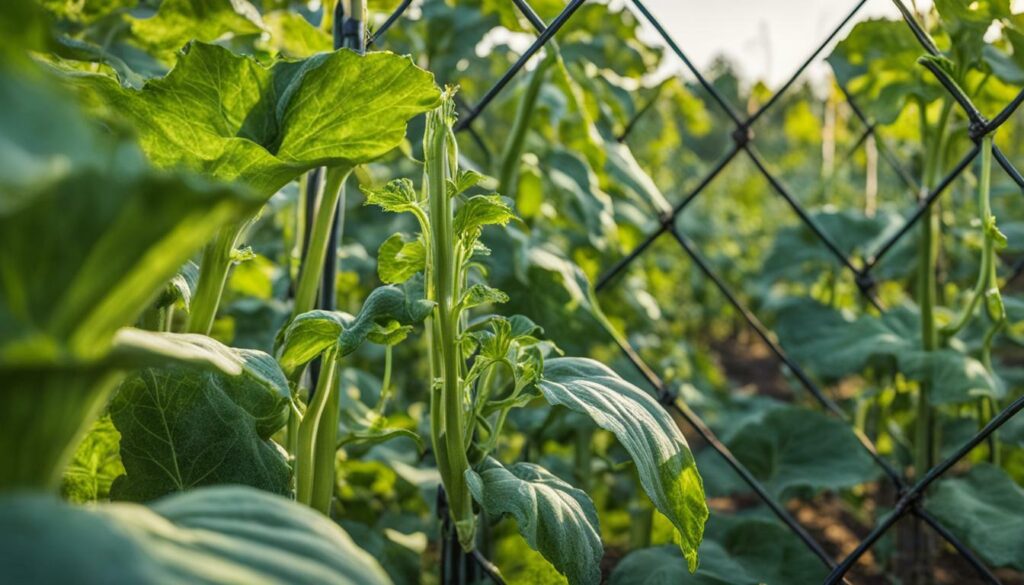
Types of Trellises for Zucchini Plants
When choosing a trellis for your vertical zucchini garden, it is important to consider the strength and durability of the structure. Zucchini plants have large vines and heavy fruits, so the trellis must be able to support their weight. Some popular types of trellises for zucchini plants include:
| Trellis Type | Description |
|---|---|
| Chicken Wire Trellis | A simple and cost-effective option, chicken wire trellises provide ample support for zucchini plants. The openings in the wire allow the vines to weave through and climb upwards. |
| Trellis Netting | Netting made of sturdy material like nylon or polypropylene is a popular choice for vertical gardening. It provides a strong structure for the zucchini plants to climb and can be easily tied to a frame or fence. |
| Cattle Panel Trellis | Cattle panels, made of galvanized steel, are sturdy and durable for supporting zucchini plants. They can be bent into an arch shape or attached to a wall or fence for vertical growing. |
These are just a few examples of trellises suitable for zucchini plants. You can choose a trellis based on your garden’s requirements and aesthetics. It is essential to ensure the trellis is securely anchored and can withstand the weight of the growing plants and fruits.
Planting Zucchini on a Trellis: Step-by-Step Guide
Planting zucchini on a trellis requires careful attention to ensure successful growth. Here is a step-by-step guide to help you get started:
- Choose a suitable location in your garden with at least six to eight hours of sunlight per day.
- Prepare the soil by loosening it to a depth of about one foot and enriching it with compost or organic mulch.
- Install the trellis securely in the ground, ensuring it can support the weight of the zucchini plants.
- Plant zucchini seeds or seedlings around three inches from the base of the trellis.
- As the zucchini plants grow, gently guide the vines towards the trellis and secure them with soft ties or twine.
- Prune the lower leaves of the zucchini plants to improve air circulation and reduce the risk of disease.
- Water the plants regularly, ensuring the soil remains consistently moist but not waterlogged.
- Harvest the zucchini fruits when they reach the desired size, typically around six to eight inches in length.
Following these steps will help you successfully grow zucchini on a trellis and enjoy a bountiful harvest.
Best Zucchini Varieties for Vertical Gardening
Not all zucchini varieties are well-suited for vertical gardening, but here are some top choices that thrive when grown vertically.
Variety 1: Black Beauty Zucchini
The Black Beauty zucchini is a popular choice for vertical gardening. It is a classic variety with dark green skin and a rich, flavorful taste. This variety produces high yields and has a compact growth habit, making it ideal for vertical trellises or cages. It is also resistant to common zucchini diseases, making it a reliable choice for gardeners.
Variety 2: Cocozelle Zucchini
Cocozelle zucchini is another excellent choice for vertical gardening. It is an heirloom variety with light green skin and pale stripes. This variety has a vining growth habit and can reach impressive heights when grown vertically. It is known for its delicious flavor and tender texture. Cocozelle zucchini is also resistant to powdery mildew, a common disease that affects zucchini plants.
Variety 3: Tromboncino Zucchini
Tromboncino zucchini, also known as climbing summer squash, is a unique variety that is perfect for vertical gardening. It has a unique shape, resembling a trombone or trumpet, hence its name. This variety has a vining growth habit and can grow up to 6 feet tall. Tromboncino zucchini produces an abundant harvest of tender and flavorful fruits.
When choosing zucchini varieties for vertical gardening, it is important to consider their growth habit and disease resistance. Look for compact or vining varieties that can thrive when trained to grow vertically. These varieties will make the most of your vertical garden space and provide you with a bountiful harvest.
| Variety | Description |
|---|---|
| Black Beauty Zucchini | Classic variety with dark green skin and high yields. Compact growth habit and resistant to diseases. |
| Cocozelle Zucchini | Heirloom variety with light green skin and tender texture. Vining growth habit and resistant to powdery mildew. |
| Tromboncino Zucchini | Unique variety with trombone-like shape. Vining growth habit and can grow up to 6 feet tall. Abundant harvest of flavorful fruits. |
Planting Zucchini on a Trellis: Step-by-Step Guide
Follow these simple steps to successfully plant zucchini on a trellis and start your vertical garden.
Step 1: Choose a location in your garden that receives at least six to eight hours of sunlight a day. Make sure there is enough space for the trellis and the zucchini plants to grow vertically.
Step 2: Prepare the soil along the length of the trellis area by turning it over to a shovel’s depth and adding compost or organic mulch for loose, well-draining soil.
Step 3: Install the trellis by placing sturdy metal rods or stakes at the ends, and additional stakes every 4 to 6 feet in between. These will provide support for the zucchini plants and their heavy fruit.
Step 4: Plant zucchini seeds or seedlings about 2 inches from the south side of the stake. This will ensure that the plants receive ample sunlight as they grow.
Step 5: As the zucchini plants begin to grow, guide their stems upwards by tying them to the trellis structure every few centimeters. This will encourage vertical growth and prevent them from bending downwards.
Step 6: Prune the leaves under the zucchini plants without damaging the stems. This will allow the plant to focus its energy on producing larger zucchinis instead of maintaining unnecessary foliage.
Step 7: Keep an eye on the zucchini plants and continue to tie any growing stems to the trellis as needed. This will help support the plants as they grow taller and produce more zucchinis.
Step 8: Harvest your zucchinis frequently to encourage more growth. Check the plants regularly for ripe zucchinis, and use a sharp knife or pruning shears to cut them from the stem.
By following these steps, you can successfully plant zucchini on a trellis and enjoy the benefits of vertical gardening. Not only will this method save space in your garden, but it will also help prevent pest problems, increase yields, and make harvesting easier.
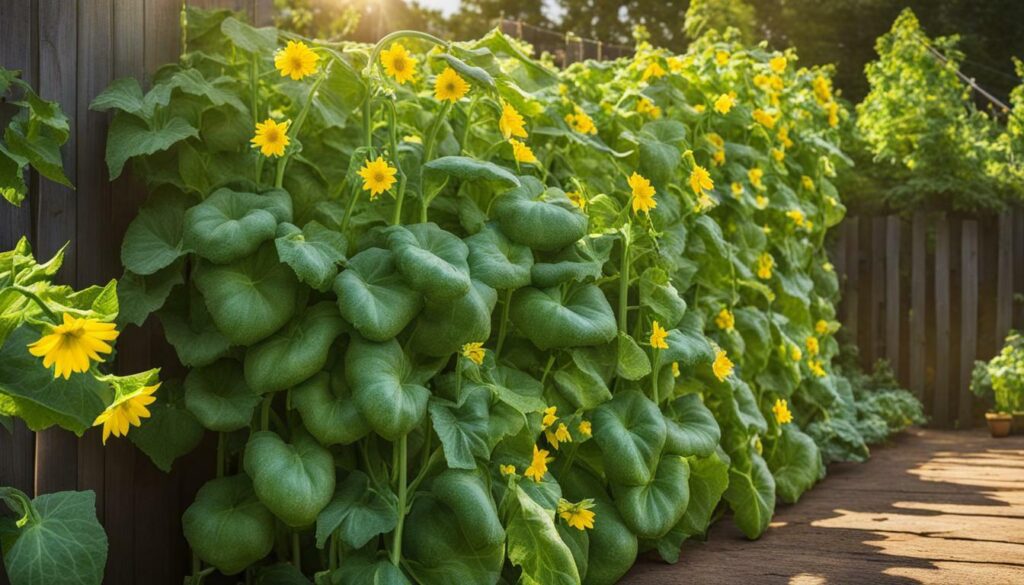
Trellis Types for Zucchini Gardening
When it comes to choosing the right trellis for your zucchini plants, there are several options to consider:
- Wire mesh trellis: This type of trellis is versatile and can support the weight of zucchini plants and their fruit. It provides ample space for the plants to climb and can be easily installed or attached to a fence or wall.
- Wooden trellis: A wooden trellis adds a natural and aesthetic appeal to your garden. It can be custom-built to fit your specific needs and can support the growth of zucchini plants effectively.
- Metal pipe trellis: Metal pipes are sturdy and durable, making them a great choice for supporting heavy zucchini plants. They can be arranged in various shapes and sizes to accommodate your garden space.
Choose a trellis that suits your gardening preferences and the specific needs of your zucchini plants. Ensure that the trellis is strong enough to withstand the weight of the plants and their fruit as they grow vertically.
| Trellis Type | Pros | Cons |
|---|---|---|
| Wire mesh trellis | Versatile, easy to install, good support | May require additional support for heavy fruits |
| Wooden trellis | Natural appeal, customizable | May require regular maintenance |
| Metal pipe trellis | Sturdy, durable, various shapes | May require more effort to install |
Consider these trellis types and their pros and cons when choosing the right one for your zucchini plants. A well-chosen trellis will provide adequate support and ensure the success of your vertical zucchini garden.
Maintaining and Pruning Zucchini in a Vertical Garden
Proper maintenance and pruning are key to ensuring healthy and productive zucchini plants in your vertical garden. By following these tips, you can optimize the growth and yield of your zucchini plants.
1. Regular Watering: Zucchinis require consistent moisture to thrive. Water your plants deeply and evenly, making sure the soil is moist but not waterlogged. Avoid overhead watering to prevent disease and fungal issues. Consider using drip irrigation or a soaker hose to deliver water directly to the base of the plants.
2. Fertilization: To promote vigorous growth and abundant fruit production, fertilize your zucchini plants regularly. Use a balanced fertilizer high in nitrogen to support leafy growth, such as a 10-10-10 or 20-20-20 formula. Follow the instructions on the fertilizer package for proper application rates and frequency.
3. Pruning Zucchini: Pruning zucchini plants is essential for managing their size and promoting good air circulation. Remove any yellow or diseased leaves, as well as any suckers or lateral shoots that emerge from the main stem. This will prevent the plants from becoming overcrowded and reduce the risk of pests and diseases.
4. Training the Vines: As your zucchini plants grow, gently guide their vines to climb up the trellis or support structure. Use soft ties or plant clips to secure the vines to the trellis, allowing them to grow vertically. This will help prevent tangling and ensure that the zucchinis grow in an upright position, making harvesting easier.
Best Practices for Vertical Zucchini Gardening Maintenance and Pruning
Here are some additional best practices to keep in mind when maintaining and pruning zucchini plants in a vertical garden:
- Monitor for pests and diseases regularly and take timely action to prevent infestations or outbreaks.
- Inspect the trellis or support structure regularly for stability and make any necessary repairs or adjustments.
- Harvest zucchinis frequently to encourage continuous production and prevent over-ripening.
- Mulch around the base of the plants to conserve moisture, suppress weeds, and regulate soil temperature.
By following these maintenance and pruning practices, you can ensure the health and productivity of your zucchini plants in a vertical garden. Enjoy the abundance of fresh zucchinis that your vertical garden will yield!
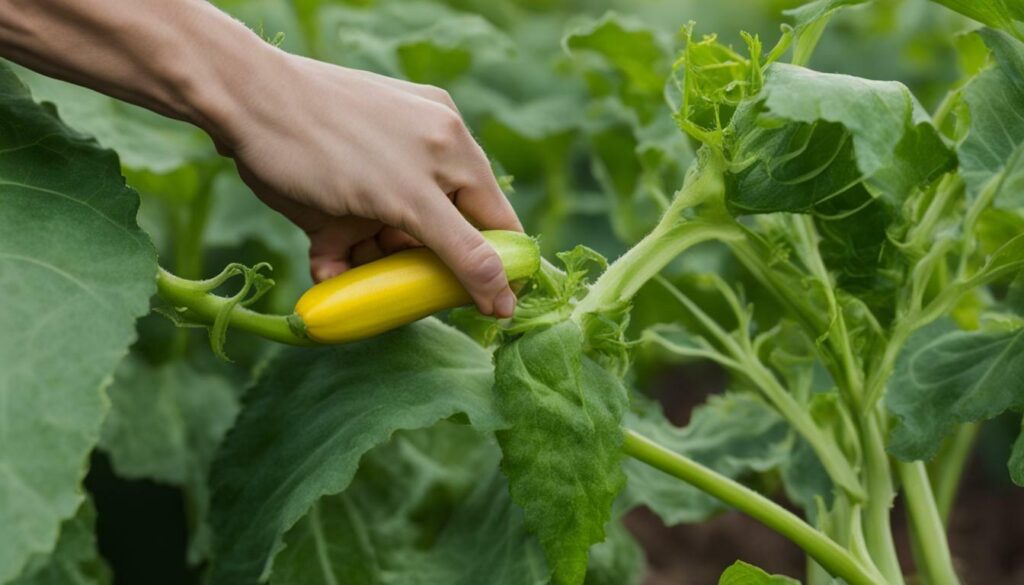
| Tip | Description |
|---|---|
| Regular Watering | Water zucchini plants deeply and evenly to maintain consistent moisture. |
| Fertilization | Use a balanced fertilizer high in nitrogen to promote vigorous growth and fruit production. |
| Pruning Zucchini | Remove yellow or diseased leaves and suckers to manage plant size and prevent overcrowding. |
| Training the Vines | Gently guide the zucchini vines to climb the trellis or support structure for upright growth. |
Remember to regularly tend to your zucchini plants in your vertical garden, and they will reward you with a bountiful harvest of delicious and healthy zucchinis!
Pest and Disease Management in Vertical Zucchini Gardening
Learn how to prevent and manage common pests and diseases that can affect zucchini plants in a vertical garden.
Growing zucchini in a vertical garden has many advantages, but it also comes with its own set of challenges. Pests and diseases can still find their way to your zucchini plants, and it’s important to be proactive in managing them to ensure a healthy and productive harvest. Here are some tips to help you prevent and control common pests and diseases in vertical zucchini gardening:
Pest Management
1. Aphids: These tiny insects can suck the sap from your zucchini plants, causing stunted growth and distorted leaves. To control aphids, regularly inspect your plants and remove them by hand or use a strong stream of water to wash them off. You can also introduce beneficial insects like ladybugs or lacewings that feed on aphids.
2. Squash Bugs: Squash bugs are notorious pests that can quickly damage your zucchini plants. To control them, regularly inspect the undersides of leaves and remove any eggs or nymphs. If infestation is severe, you can use insecticidal soap or neem oil spray as a last resort.
3. Vine Borers: These pests can bore into the stems of your zucchini plants, causing wilting and eventually plant death. To prevent vine borers, cover the base of your plants with a physical barrier like aluminum foil or pantyhose to prevent the adult moths from laying eggs on the stems.
Disease Management
1. Powdery Mildew: Powdery mildew is a common fungal disease that can affect zucchini plants in vertical gardens. To prevent powdery mildew, ensure adequate air circulation around your plants by spacing them properly and avoid overhead watering. If powdery mildew does appear, remove and destroy infected leaves, and apply a fungicide if necessary.
2. Bacterial Wilt: Bacterial wilt is a serious disease transmitted by cucumber beetles, which can cause wilting and collapse of zucchini plants. To manage bacterial wilt, control cucumber beetle populations by using sticky traps or applying organic insecticides. Remove and destroy infected plants to prevent the spread of the disease.
3. Blossom End Rot: Blossom end rot is a physiological disorder caused by calcium deficiency. To prevent blossom end rot, ensure consistent soil moisture by watering regularly and maintaining proper soil pH and nutrient levels. Adding organic matter like compost can also help improve soil structure and calcium availability.
| Pest/Disease | Prevention | Control |
|---|---|---|
| Aphids | Regular inspection, hand removal, beneficial insects | Insecticidal soap, neem oil |
| Squash Bugs | Regular inspection, egg and nymph removal | Insecticidal soap, neem oil |
| Vine Borers | Physical barriers at base of plants | N/A |
| Powdery Mildew | Adequate air circulation, proper spacing, avoid overhead watering | Remove infected leaves, fungicide if necessary |
| Bacterial Wilt | Cucumber beetle control | Remove infected plants |
| Blossom End Rot | Consistent soil moisture, proper pH and nutrient levels | Improving soil structure, adding compost |
By following these pest and disease management tips, you can ensure a successful and healthy vertical zucchini gardening experience. Regular monitoring, proper prevention methods, and timely intervention will help you maintain thriving zucchini plants and maximize your harvest.
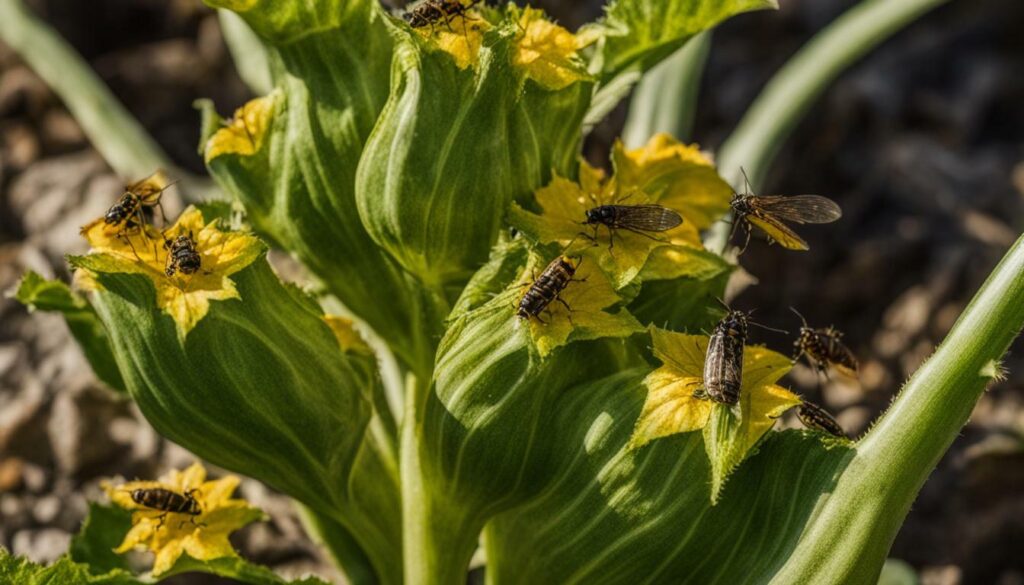
Remember, a healthy garden requires attention and care, but the rewards of fresh zucchini from your vertical garden will make it all worthwhile!
Harvesting and Using Zucchini from a Vertical Garden
Discover the art of harvesting zucchini at the peak of ripeness and explore delicious recipes to make the most of your vertical garden’s bounty. Growing zucchini vertically not only saves space in your garden but also makes it easier to maintain and harvest your crop. In this section, we will delve into the techniques of harvesting zucchini and creative ways to utilize the abundant harvest from a vertical garden.
When it comes to harvesting zucchini, timing is everything. Zucchinis should be harvested when they are around 6-8 inches long and have a firm texture. Be sure to check your zucchini plants regularly as they can grow quickly, especially in warm weather. Leaving zucchinis on the plant for too long can result in oversized fruits with tough skin and seeds. To harvest zucchinis, simply use a sharp knife or garden shears to cut the stem just above the fruit. Avoid pulling or twisting the zucchinis off the plant as this can damage the plant and affect future growth.
Once you have harvested your zucchinis, it’s time to get creative in the kitchen! Zucchinis are incredibly versatile and can be used in a variety of dishes. From refreshing salads to comforting soups, zucchinis can be incorporated into both savory and sweet recipes. Grilled zucchini slices can be a delicious addition to sandwiches and burgers, while zucchini noodles make a healthy alternative to traditional pasta. You can even use zucchinis in baking, adding moisture and nutrients to breads, muffins, and cakes.
To help inspire your culinary adventures with zucchini, here is a recipe for a simple yet delicious dish:
“Grilled Zucchini Salad with Fresh Herbs”
Ingredients:
- 2 medium zucchinis
- 2 tablespoons olive oil
- 1 tablespoon lemon juice
- 2 cloves garlic, minced
- Salt and pepper to taste
- 1/4 cup fresh herbs (such as basil, parsley, or mint), chopped
Instructions:
- Preheat a grill or grill pan over medium heat.
- Trim the ends off the zucchinis and cut them lengthwise into thin slices.
- In a small bowl, whisk together the olive oil, lemon juice, minced garlic, salt, and pepper.
- Brush the zucchini slices with the olive oil mixture, coating both sides.
- Grill the zucchini slices for 2-3 minutes per side, or until they are tender and have grill marks.
- Remove the zucchini slices from the grill and transfer them to a serving platter.
- Sprinkle the fresh herbs over the grilled zucchini and serve.
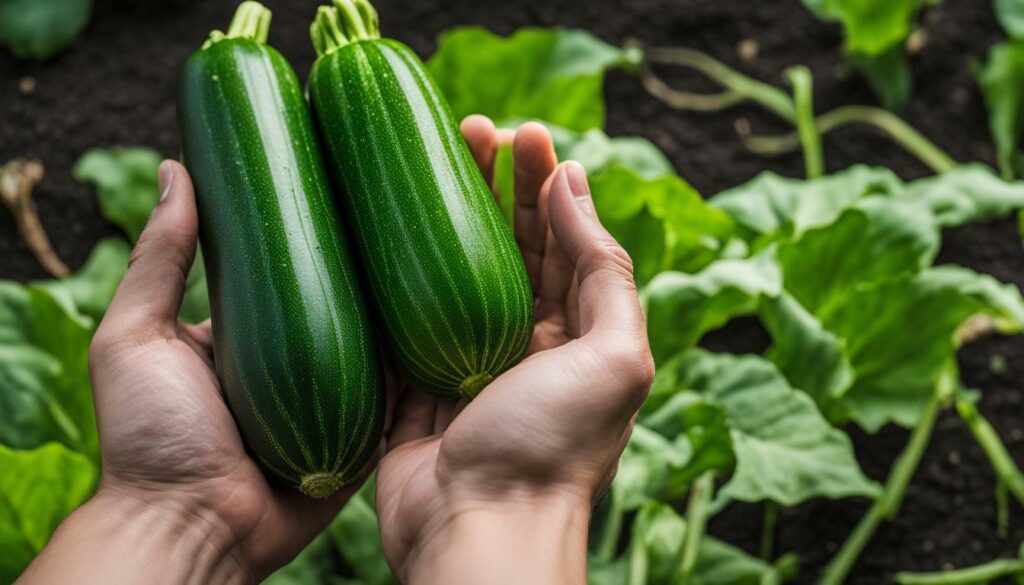
In addition to this recipe, there are countless other ways to enjoy the bountiful harvest from your vertical garden. Whether you incorporate zucchinis into stir-fries, frittatas, or even desserts, the possibilities are endless. Get creative and experiment with different flavors and cooking techniques to make the most of your homegrown zucchinis. Happy harvesting and bon appétit!
Summary:
In this section, we have explored the art of harvesting zucchini from a vertical garden. We have learned about the importance of timing in harvesting zucchinis and the techniques to ensure a successful harvest. Additionally, we have provided a delicious recipe for Grilled Zucchini Salad with Fresh Herbs to inspire culinary creativity with zucchinis. Remember, zucchinis are versatile and can be used in a multitude of dishes, so let your imagination run wild and enjoy the flavors of your vertical garden’s bounty.
| Advantages of Growing Zucchini Vertically | What Kind of Trellis Should I use To Grow Zucchini Vertically? | How to Plant Zucchini on a Trellis – Step-by-Step |
|---|---|---|
| – Save space in your garden | – Any shape and type of trellis at least 6 feet tall will be fine for zucchini and squash | – Choose a location in your garden with enough shade from a 6-foot-tall trellis |
| – Fewer pest problems from being far from the ground. Therefore, increasing yields | – Trellis must be robust enough to sustain the heavy fruit and large vines | – Prepare the soil and mark the locations for rebar posts |
| – Don’t lean down to harvest zucchini | – Zucchini grows vertically only if you help them to do so by tying up the stems to the trellis | – Set up the structure and plant or transplant the seedlings |
Now that you have mastered the art of harvesting zucchini from a vertical garden, it’s time to enjoy the flavors and versatility of this delicious vegetable. Try different recipes and cooking techniques to make the most of your homegrown zucchinis and savor the rewards of your vertical gardening efforts.
Troubleshooting Common Issues in Vertical Zucchini Gardening
Don’t let setbacks discourage you – here are some common issues in vertical zucchini gardening and how to overcome them.
1. Poor Pollination: Zucchini plants rely heavily on pollinators, such as bees, to transfer pollen from the male to the female flowers. Without proper pollination, the fruits may not develop fully or may become misshapen. To encourage pollination, you can attract bees to your garden by planting bee-friendly flowers nearby. Additionally, you can manually pollinate the flowers using a small paintbrush or cotton swab to transfer pollen from the male to the female flowers.
2. Overcrowding: Vertical gardening can save space, but it’s important not to overcrowd your zucchini plants. When plants are too close together, they can compete for sunlight, water, and nutrients, resulting in stunted growth and smaller yields. To prevent overcrowding, ensure that there is enough space between each plant or vine on the trellis. This will allow for proper air circulation and reduce the risk of disease.
3. Insufficient Support: Zucchini plants can become heavy and require sturdy support to prevent them from toppling over. If the trellis or other vertical structure is not strong enough, it may collapse under the weight of the plants and fruits. Choose a trellis made from durable materials, such as metal or strong wood, and ensure that it is securely anchored in the ground. Regularly check the trellis for any signs of weakness and make any necessary repairs or replacements.
4. Inadequate Watering: Zucchini plants need consistent and adequate watering to thrive. They require about 1 inch of water per week, especially during hot and dry periods. Insufficient watering can lead to stunted growth, wilting, and reduced fruit production. Monitor the moisture levels in the soil and water the plants deeply at the base, ensuring that the water reaches the roots. Consider using drip irrigation or a soaker hose to provide a steady supply of water directly to the plants.
By addressing these common issues, you can overcome challenges in vertical zucchini gardening and enjoy a successful harvest. Remember to monitor your plants closely, provide proper support, and maintain optimal growing conditions. With patience and care, you’ll be rewarded with a bountiful crop of delicious zucchinis.
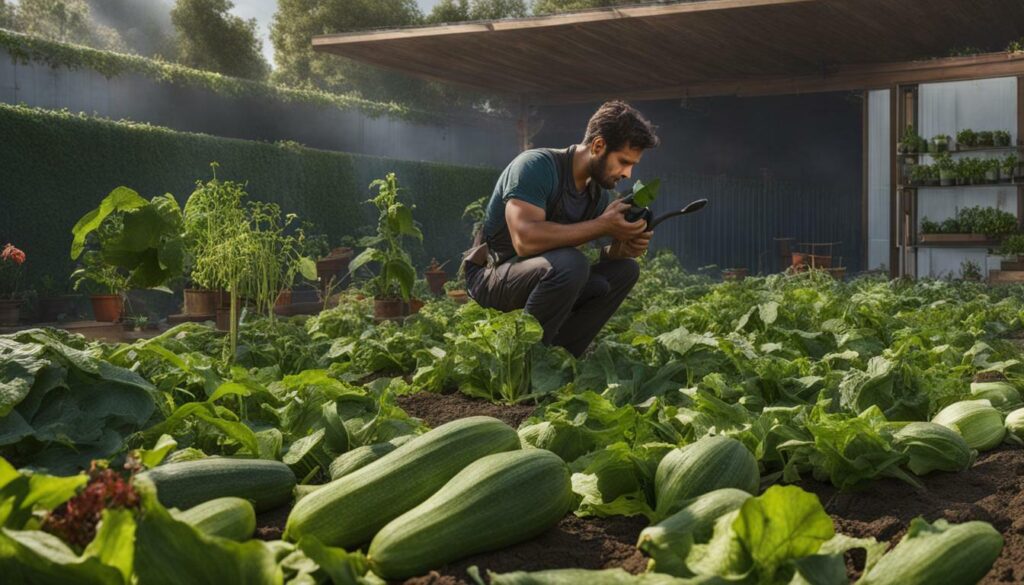
Table: Common Issues in Vertical Zucchini Gardening
| Issue | Solution |
|---|---|
| Poor Pollination | Attract pollinators, manually pollinate flowers |
| Overcrowding | Ensure proper spacing between plants/vines |
| Insufficient Support | Choose a strong trellis, regularly inspect and repair |
| Inadequate Watering | Water deeply, monitor soil moisture |
Vertical Zucchini Gardening Success Stories
Hear inspiring stories from successful US gardeners who have mastered the art of vertical zucchini gardening and achieved impressive results.
Tom from California started growing zucchini vertically in his backyard garden a few years ago. He was amazed at the space-saving benefits and increased yields he achieved. Tom used a sturdy trellis to support his zucchini plants, allowing them to grow vertically. Not only did this save him valuable gardening space, but it also made it easier to harvest the zucchini without bending down. Tom’s vertical zucchini garden became the talk of the neighborhood, and he was able to share his abundant harvest with friends and family.
Emily, a gardener from New York, decided to try growing zucchini vertically in her small urban garden. She used a combination of trellises and containers to create a vertical garden that maximized her limited space. Emily was thrilled with the results. Her zucchini plants thrived and produced a bountiful harvest. She even had enough zucchini to donate to a local food bank. Emily’s success with vertical zucchini gardening inspired her neighbors to try it as well, and they were amazed at the results they achieved.
John, a novice gardener from Texas, had always struggled to grow zucchini in his traditional garden beds. Frustrated with his lack of success, he decided to give vertical gardening a try. John built a simple trellis system using bamboo poles and twine. To his surprise, his zucchini plants flourished. The vertical growth allowed for better air circulation and reduced pest problems. John’s neighbors were so impressed with his vertical zucchini garden that they began asking for tips and advice on how to start their own.
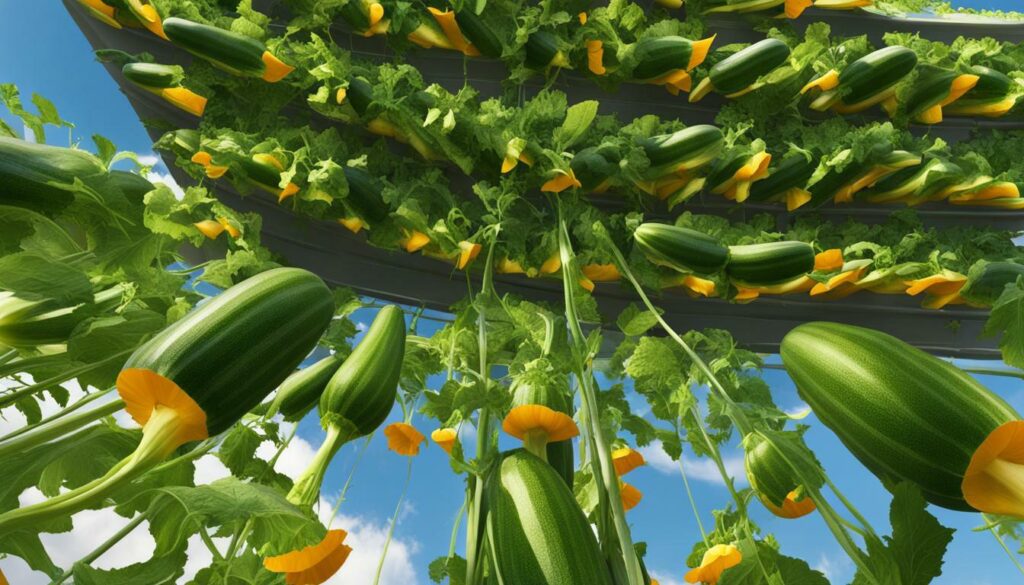
These success stories demonstrate the potential of vertical zucchini gardening for US gardeners. By growing zucchini vertically, you can save space, increase your yields, and overcome common gardening challenges. Whether you have a small urban garden or a spacious backyard, vertical zucchini gardening can be a rewarding and efficient way to grow this versatile vegetable.
Vertical Zucchini Gardening Tips:
- Choose a sturdy trellis or support structure for your zucchini plants.
- Ensure adequate sunlight and air circulation for your vertical zucchini garden.
- Regularly prune and train your zucchini plants to grow vertically.
- Harvest zucchini frequently to encourage more growth.
- Consider using organic pest management methods to protect your zucchini plants.
- Water your vertical zucchini garden regularly, keeping the soil moist but not waterlogged.
By following these tips and learning from the success stories of other US gardeners, you can achieve impressive results with vertical zucchini gardening. Start growing your own vertical zucchini garden today and enjoy a bountiful harvest of this delicious and versatile vegetable.
Tips for Extending the Vertical Zucchini Growing Season
Learn how to extend the growing season for your vertical zucchini garden and enjoy an extended harvest.
One way to extend the growing season for your vertical zucchini garden is by starting your plants early. Zucchini plants thrive in warm weather, so starting them indoors from seeds or purchasing young seedlings can give you a head start. Planting them in your garden once the danger of frost has passed will allow them to establish themselves before the heat of summer arrives.
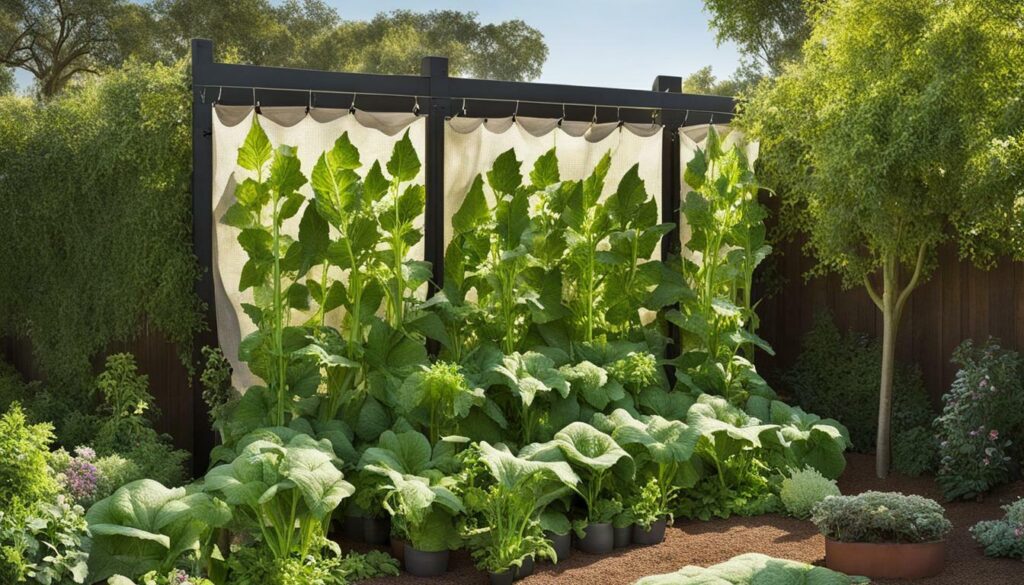
Another method to extend the growing season is by using row covers or cloches to protect your zucchini plants from late spring frosts or early fall frosts. These covers help to create a microclimate around your plants, providing them with extra warmth and protection. Be sure to remove the covers during the day to allow for proper airflow and pollination.
To maximize your zucchini harvest, consider using companion planting techniques. Planting cold-tolerant crops such as lettuce or spinach alongside your zucchini can provide shade and protection during hot summer months, allowing your zucchini plants to thrive for a longer period. Additionally, interplanting with flowers such as marigolds can help deter pests and attract beneficial pollinators.
Regularly check your zucchini plants for any signs of disease or pest infestation. Quick action at the first sign of trouble can help prevent the spread of disease and minimize damage to your plants. Pruning any affected leaves or using organic pest control methods can help keep your zucchini plants healthy and productive throughout the growing season.
| Tip | Description |
|---|---|
| Start Early | Begin your zucchini plants indoors from seeds or young seedlings to give them a head start. |
| Use Row Covers | Protect your zucchini plants from late spring or early fall frosts by using row covers or cloches. |
| Companion Planting | Plant cold-tolerant crops or flowers alongside your zucchini to provide shade, protection, and attract beneficial insects. |
| Pest and Disease Management | Regularly inspect your zucchini plants for signs of pests or disease and take appropriate action to prevent damage. |
“Extending the growing season for your vertical zucchini garden can lead to a more abundant harvest and a longer period of enjoying fresh zucchinis. By implementing these tips, you can maximize the productivity of your garden and savor the flavors of homegrown zucchinis for an extended period.”
Conclusion
Congratulations! You are now equipped with the knowledge and techniques to master vertical garden zucchini and elevate your gardening skills. By growing zucchini vertically, you can enjoy the benefits of space-saving, increased yields, and a thriving garden. Whether you choose to plant zucchini on a trellis or utilize a vertical garden, the advantages are numerous.
Planting zucchini vertically saves valuable ground space in your garden, allowing you to grow more crops in a smaller area. This means less maintenance, weeding, and watering, giving you more time to enjoy your garden. Additionally, vertical gardening helps prevent pest problems by keeping the plants off the ground and allows for easier harvesting without having to bend down.
When selecting a trellis for vertical zucchini gardening, choose a sturdy structure that can support the weight of the vines and heavy fruit. There are various trellis options available, such as wire mesh, wooden frames, or metal pipes. Consider the size of your zucchini plants and the space available in your garden when choosing the appropriate trellis.
It is important to choose zucchini varieties that are suitable for vertical gardening. While not all zucchini plants are naturally inclined to grow vertically, open bush and vining varieties can be trained to grow upwards. By selecting the right variety, you can maximize your vertical zucchini garden’s potential and ensure a bountiful harvest.
Follow our step-by-step guide to planting zucchini on a trellis for successful vertical gardening. Remember to guide the vines as they grow and tie them to the structure to ensure vertical growth. Regular maintenance and pruning are essential for keeping the plants healthy and productive. By addressing common issues and implementing pest and disease management strategies, you can minimize potential problems in your vertical zucchini garden.
When the time comes to harvest your zucchinis, make sure to do so frequently. Regular harvesting encourages more zucchini to grow and prevents them from becoming oversized and woody. Get creative in the kitchen and utilize your abundant zucchini harvest in various recipes, from stir-fries to baked goods.
If you encounter any challenges along the way, refer to our troubleshooting section for solutions. Remember that every garden is unique, and it may require some trial and error to find what works best for your vertical zucchini garden. Don’t be discouraged if you face setbacks; learning from your experiences is part of the gardening journey.
To further inspire and motivate you, we’ve shared success stories from US gardeners who have achieved remarkable results with vertical zucchini gardening. Their experiences serve as a testament to the potential and rewards of this innovative gardening technique.
Finally, extend your growing season and maximize your vertical zucchini harvest with our tips for extending the growing season. By implementing these techniques, you can enjoy fresh zucchinis for longer periods and make the most of your vertical garden.
Now that you have the tools and knowledge, it’s time to start growing zucchini vertically and experience the joys and benefits of this space-saving technique. Happy gardening!
Can the Techniques for Growing Zucchini in a Vertical Garden be Applied to Growing Tomatoes?
Yes, the techniques for growing zucchini in a vertical garden can definitely be applied to growing tomatoes. Utilizing a vertical garden for tomatoes can help conserve space, provide better air circulation, and make harvesting easier. With proper support and regular pruning, tomatoes can thrive in a vertical garden setting.
FAQ
Q: Why should I grow zucchini vertically?
A: Growing zucchini vertically saves space in your garden, increases yields, and prevents pest problems. It also makes harvesting easier and allows for better air circulation and sunlight for the plants.
Q: What kind of trellis should I use for vertical zucchini gardening?
A: Any shape and type of trellis at least 6 feet tall will work for zucchini. It should be strong enough to support the heavy fruit and large vines.
Q: What are the best zucchini varieties for vertical gardening?
A: While closed bush zucchini varieties are not suitable for vertical gardening, open bush and vining varieties can be grown vertically. Some recommended varieties include Caserta, Greyzinni, and Golden Glory.
Q: How do I plant zucchini on a trellis?
A: Start by choosing a location with enough sunlight and space for the trellis. Prepare the soil and mark the locations where the trellis posts will be installed. Plant or transplant the zucchini seedlings near the trellis, and as they grow, tie them to the structure and prune the leaves below the zucchini.
Q: How do I maintain and prune zucchini in a vertical garden?
A: Regularly check and tie the zucchini plants to the trellis as they grow. Prune the leaves below the zucchini to redirect the plant’s energy towards fruit production. Remove any damaged or diseased leaves to prevent the spread of diseases.
Q: How do I manage pests and diseases in vertical zucchini gardening?
A: Regularly monitor the zucchini plants for pests such as squash bugs and vine borers. Use organic pest control methods like handpicking or spraying with insecticidal soap. Keep the plants well-watered and avoid over-watering to prevent fungal diseases.
Q: How do I harvest and use zucchini from a vertical garden?
A: Harvest zucchini when they are young and tender, typically around 6-8 inches in length. Use them in various recipes such as stir-fries, salads, or bread. You can also freeze or pickle zucchini for later use.
Q: What are some common issues in vertical zucchini gardening and how do I troubleshoot them?
A: Common issues in vertical zucchini gardening include poor pollination, powdery mildew, and overcrowding. To address poor pollination, manually pollinate the flowers using a Q-tip or paintbrush. For powdery mildew, use fungicides or increase air circulation. If overcrowding occurs, thin out the plants to allow for better growth and airflow.
Q: Do you have any success stories from US gardeners who have tried vertical zucchini gardening?
A: Yes, many US gardeners have achieved great results with vertical zucchini gardening. They have reported higher yields, easier maintenance, and more efficient use of garden space. Vertical zucchini gardening has allowed them to grow more zucchini in less space.
Q: How can I extend the vertical zucchini growing season?
A: To extend the growing season, start the zucchini plants indoors or in a greenhouse before transferring them to the vertical garden. You can also use protective coverings like row covers or cold frames to shield the plants from cold temperatures.

